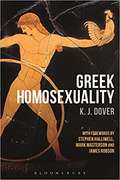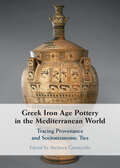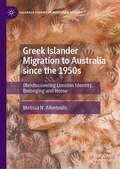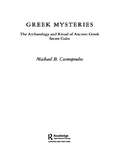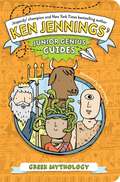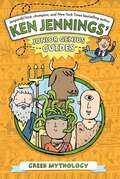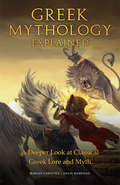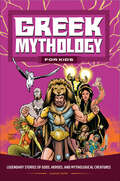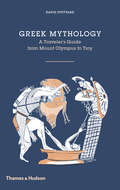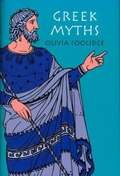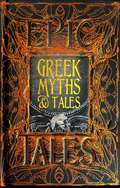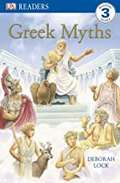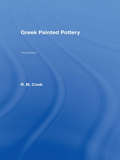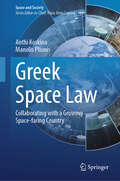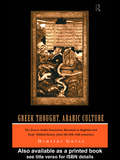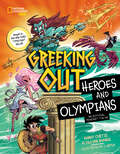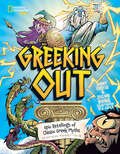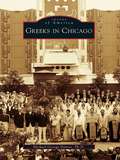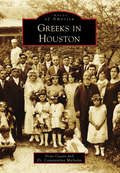- Table View
- List View
Greek Homosexuality
by K. J. DoverHailed as magisterial when it first appeared, Greek Homosexuality remains an academic milestone and continues to be of major importance for students and scholars of gender studies. Kenneth Dover explores the understanding of homosexuality in ancient Greece, examining a vast array of material and textual evidence that leads him to provocative conclusions. <p> This new release of the 1989 second edition, for which Dover wrote an epilogue reflecting on the impact of his book, includes two specially commissioned forewords assessing the author's legacy and the place of his text within modern studies of gender in the ancient world.
Greek Iron Age Pottery in the Mediterranean World: Tracing Provenance and Socioeconomic Ties
by Stefanos GimatzidisGreek pottery is the most visible archaeological evidence of social and economic relations between the Aegean and the Mediterranean during the Iron Age, a period of intense mobility. This book presents a holistic study of the earliest Greek pottery exchanged in Greek, Phoenician, and other Indigenous Mediterranean cultural contexts from multidisciplinary perspectives. It offers an examination of 362 Protogeometric and Geometric ceramic and clay samples, analysed by Neutron Activation, that Stefanos Gimatzidis obtained in twenty-four sites and regions in eight countries. Bringing a macro-historical approach to the topic through a systematic survey of early Greek pottery production, exchange, and consumption, the volume also provides a micro-history of selected ceramic assemblages analysed by a team of scholars who specialise in Classical, Near Eastern, and various prehistoric archaeologies. The results of their collaborative archaeological and archaeometric studies challenge previous reconstructions of intercultural relations between the Aegean and the Mediterranean and call into question established narratives about Greek and Phoenician migration.
Greek Islander Migration to Australia since the 1950s: (Re)discovering Limnian Identity, Belonging and Home (Palgrave Studies in Migration History)
by Melissa N. AfentoulisIlluminating the experiences of immigrants to Australia in the late twentieth century, this book uses oral history to explore how identity and belonging are shaped through migration. Between the 1950s and the 1970s, many inhabitants from the small Greek island of Limnos travelled to Australia to flee post-war devastation and economic disaster. With an emphasis on the lived experiences and memories of Limnians, the book sheds light on the emotional pain and trauma they felt as they were separated from their families and homeland. Moving away from more traditional outlooks on migration studies, this book emphasises the significance of ethno-regional identity, and analyses how it can bring strength and longevity to a constructed community. Both the roles of men and women within the Greek diaspora are examined, in the way that they made the difficult decision to leave their homeland, and subsequently how they came to nurture and build families within a new, evolving community. Looking beyond first-generation migration, the author analyses the pattern of return visits to Limnos by the descendants of migrants. Acting as a form of identity consolidation for second-generation migrants, this journey to the ancestral homeland highlights the fluidity of what it means to belong somewhere, and redefines the notion of ‘home’. The author provides an alternative perspective to traditional migration studies and reaffirms the importance of transnational identity. A unique and important addition to research, this book combines memory studies and oral narrative to analyse how identity and belonging can be shaped across borders, rather than within them.
Greek Mysteries: The Archaeology of Ancient Greek Secret Cults
by Michael B. CosmopoulosWritten by an international team of acknowledged experts, this excellent book studies a wide range of contributions and showcases new research on the archaeology, ritual and history of Greek mystery cults. With a lack of written evidence that exists for the mysteries, archaeology has proved central to explaining their significance and this volume is key to understanding a phenomenon central to Greek religion and society.
Greek Mythology (Ken Jennings’ Junior Genius Guides)
by Ken JenningsUnleash your inner genius and become a master of mythology with this interactive trivia book from Jeopardy! champ and New York Times bestselling author Ken Jennings.With this Junior Genius Guide to Greek mythology, you’ll become an expert and wow your friends and teachers with all the best ancient stories: how Prometheus outsmarted the gods, how Achilles’s heel led to his death, and how we mere mortals always seem to get mixed up in so many misadventures. With great illustrations, cool trivia, and fun quizzes to test your knowledge, this guide will have you on your way to whiz-kid status in no time!
Greek Mythology (Ken Jennings’ Junior Genius Guides)
by Ken JenningsUnleash your inner genius and become a master of mythology with this interactive trivia book from Jeopardy! host and champion and New York Times bestselling author Ken Jennings.With this Junior Genius Guide to Greek mythology, you&’ll become an expert and wow your friends and teachers with all the best ancient stories: how Prometheus outsmarted the gods, how Achilles&’s heel led to his death, and that most of our eighty-eight constellations are based on what Greeks and Romans imagined thousands of years ago! With great illustrations, cool trivia, and fun quizzes to test your knowledge, this guide will have you on your way to whiz-kid status in no time!
Greek Mythology Explained: A Deeper Look at Classical Greek Lore and Myth
by Marios Christou David RamenahA unique retelling of Greek mythological tales featuring love, betrayal, murder and ruthless ambitions—for fans of George R. R. Martin’s Game of Thrones.Discover six classic Greek myths in this exciting retelling that paints both famous and lesser-known characters in a whole new light. Follow the likes of Odysseus, Lamia, Bellerophon, Icarus, Medusa and Artemis as their fates are revealed through bloody trials, gut-wrenching betrayals, sinister motives and broken hearts. With an accessible writing style that delves into the thoughts, feelings, desires, and motivations of every character, these mythical figures and their compelling stories will resonate with readers as they are guided through perilous and tragic adventures.Greek Mythology Explained provides an in-depth analysis of each story told as it unravels the greater themes and valuable lessons hidden within each chapter. Inside these pages, you’ll . . .Sail with Odysseus as he navigates through the straits of Messina with a terrifying monster on each side, intent only on killing him and his crew.Witness Lamia’s world turned upside down as she loses her kingdom, her children and her humanity.Journey with Bellerophon as he battles the Chimera and becomes the hero that he was destined to be.Take flight with Icarus and Daedalus as they escape their confinement and the Cretan navy.Follow Medusa as she loses faith in the gods and becomes the monster she so adamantly wished to protect her people from.Experience the love between Artemis and Orion, as well as the bitter jealousy it spawns at the core of her brother Apollo.
Greek Mythology for Kids: Legendary Stories of Gods, Heroes, and Mythological Creatures
by Zachary HambyWhether you're fighting alongside Zeus in the war against the Titans or witnessing the sabotage of Artemis's love for the mortal Orion, this Greek mythology book for kids 8 to12-year-olds will thrill with extraordinary stories from Greek legend! Greek gods and goddesses continue to capture our imaginations with tales of epic battles and star-crossed love. Experience adventure and enchantment with this book about Greek mythology.Greek Mythology for Kids has it all:Classic characters—Dive into 20 exciting, kid-friendly tales featuring the antics of favorite characters like Aphrodite, the goddess of love, Hermes, messenger of the gods, and Persephone, queen of the underworld. Dramatic illustrations—Watch the awe-inspiring world of Greek mythology come to life with the bold art in the style of a graphic novel for kids. A guide to the Greeks—Learn who did what and where with a handy guide to characters and locations that makes exploring Greek mythology fun and easy. Venture into the unknown with Greek Mythology for Kids!
Greek Mythology: A Traveler's Guide
by David StuttardA hands-on traveler's guide to the enthralling tales of Greek mythology, organized around the cities and landscapes where the events are set The Greek myths have a universal appeal, beyond the time and physical place in which they were created. But many are firmly rooted in specific landscapes: the city of Thebes and mountain range Cithaeron dominate the tale of Oedipus; the city of Mycenae broods over the fates of Agamemnon and Electra; while Knossos boasts the scene of Theseus' slaying of the Minotaur. Drawing on a wide range of classical sources, newly translated by the author, and illustrated with specially commissioned drawings, this book is both a useful read for those visiting the sites and a fascinating imaginative journey for the armchair traveler. The itinerary includes twenty-two locations, from Mount Olympus to Homer's Hades, recounting the myths and history associated with each site and highlighting features that visitors can still see today. Scholarly text, supported by quotes from primary sources and contemporary research, as well as the enticing stories of gods and goddesses, heroes and villains, enrich the reader's literal or simply literary experience of these sites, whose significance still resonates today.
Greek Mythology: From Aphrodite to Zeus, a Profile of Who's Who in Greek Mythology (World Mythology and Folklore Series)
by Liv AlbertFinally sort out who&’s who in Greek mythology—from gods, goddesses, heroes, monsters, and everyone in between!Greek mythology continues to appear in popular movies and books today but have you ever wondered about where these characters started out? Discover the origins of your favorite characters from Greek mythology with this collection of profiles to tell you who&’s who in classical lore! In Greek Mythology, you will discover the backstories of the heroes, villains, gods, and goddesses that enjoy popularity in today&’s shows and films. With comprehensive entries that outline each character&’s name, roles, related symbols, and foundational myths, you can get to know the roots of these personas and better understand the stories they inspire today. With this character-focused, handy reference, you will never be confused about Ancient Greece!
Greek Mythology: Gods and Heroes Brought to Life
by Robert GarlandThe timeless stories of Greek mythology come to life in these reimagined tales written in the voices of Zeus, Oedipus, Odysseus, and many others.Though the gods are featured prominently in Greek mythology, there is nothing sacred about it. Anyone is free to bring their own interpretation to these stories, just as Homer, Sophocles, and Euripides did centuries ago. In this volume, classicist and author Robert Garland presents nearly forty Greek legends as told by the characters themselves. Telling their stories from their own perspectives, the famous characters of Greek mythology—both gods and mortals—are given a chance to reflect on their lives and defend actions. Each story is accompanied by historical commentary, making Greek Mythology: Gods and Heroes Brought to Life an engaging and accessible way to enjoy these timeless tales.
Greek Mythology: Gods and Heroes Brought to Life
by Robert GarlandThe timeless stories of Greek mythology come to life in these reimagined tales written in the voices of Zeus, Oedipus, Odysseus, and many others.Though the gods are featured prominently in Greek mythology, there is nothing sacred about it. Anyone is free to bring their own interpretation to these stories, just as Homer, Sophocles, and Euripides did centuries ago. In this volume, classicist and author Robert Garland presents nearly forty Greek legends as told by the characters themselves. Telling their stories from their own perspectives, the famous characters of Greek mythology—both gods and mortals—are given a chance to reflect on their lives and defend actions. Each story is accompanied by historical commentary, making Greek Mythology: Gods and Heroes Brought to Life an engaging and accessible way to enjoy these timeless tales.
Greek Myths
by Olivia E. Coolidge Edouard SandozFrom the terror of Medusa and the Minotaur to the Labors of Heracles and journeys of Theseus, the stories in this collection have thrilled and enthralled people for centuries with their high drama, hazardous quests, and unforgettable characters (both mortal and immortal). Under Olivia Coolidge#146;s skillful pen, the landscape of early Greece and its famous legends bloom with vigor and are perfectly suited to the adventure-seeking reader.
Greek Myths
by Marcia WilliamsGreek myths are among the most exciting stories ever told. In this collection, Williams retells eight myths using simple language and a unique comic-strip format. <P><P>Panels and spreads brimming with color and nonstop action make each tale a pleasure to look at and voice balloons add modern humor. The perfect way to introduce young readers to the power of myths.
Greek Myths & Tales: Epic Tales (Gothic Fantasy)
by Flame Tree StudioA potent pantheon of gods, heroes engaged in epic battles, fearsome mythical creatures and supernatural transformations – such fantastical elements infuse Greek myths with a wonder and excitement that&’s hard to beat. These tales of love, courage, conflict and intrigue, shared for thousands of years, still exercise a powerful influence on our modern lives.
Greek Myths (Dk Readers Level 3 Ser.)
by Deborah LockThis book introduces the child to the pantheon of Greek gods and goddesses and the myths surrounding them.
Greek Myths For Young Children
by Jenny Tyler Heather Amery Linda Edwards Amanda BarlowThe Greek myths are a fascinating part of our cultural heritage, and young children will find these stories of gods, mortals and monsters irresistible. This collection of the best-known stories are retold in a magical and sensitive way.
Greek Painted Pottery
by R M **Decd** R. M. CookGreek Painted Pottery has been used by classics and classical archaeology students for some thirty years. It thoroughly examines all painted pottery styles from the Protogeometric to the Hellenistic period from all areas of Greece and from the colonies in parts of Italy. In each case it covers the development of iconography and the use of colour, decorative motifs and the distinctive styles of each stage. It examines the most utilitarian pottery objects as well as some of the finest pieces produced by a flourishing civilisation. Other chapters cover the pottery industry and pottery-making techniques, including firing, the types of local clay which were used and inscription. This study also considers how one can date pottery and establish a chronology and the various methods by which these artefacts have been classified, preserved and collected.This is the third edition of this classic text, which has been extensively revised and includes a fully updated bibliography. This edition also includes coverage of new evidence and new theories which have surfaced since the book was last revised in 1972. With over 100 black and white photographs and plentiful line drawings, the new edition of this comprehensive text will be invaluable to students studying classical art, archaeology and art history.
Greek Space Law: Collaborating with a Growing Space-faring Country (Space and Society)
by Manolis Plionis Anthi KoskinaThis book provides an overview of the Greek legislation applying to space activity under the responsibility of the Greek State, as in line with international space law. Greece is not an established space-faring country; however, it is showing particular dynamism, making the most of its participation in international and EU space endeavors. Indeed, along with outstanding achievements in space science Greece took legislative action both at the international and national levels (proposals at the UNCOPUOS; Greek space law; signing of the Artemis Accords). Hence, the time has come to refer to – and present aspects of – the Greek space legislation. After an introductory section, the book provides information first on the national laws providing for the Greek participation in international space systems and in EU activities, which could be regarded as being the initial steps of Greece in the context of space. Thereafter, the rules applying to Greek space activity per se are presented, focusing on the authorities competent to decide on space matters, then on the substantial law rules allowing for – and clarifying – the application of international space law to domestic space operations. This book presents an overall view and analysis of the Greek space legislation, adding valuable information to the existing bibliography. Included as an appendix is a scholarly translation of the 2017 Greek space law.
Greek Thought, Arabic Culture: The Graeco-Arabic Translation Movement in Baghdad and Early 'Abbasaid Society (2nd-4th/5th-10th c.)
by Dimitri GutasFrom the middle of the eighth century to the tenth century, almost all non-literary and non-historical secular Greek books, including such diverse topics as astrology, alchemy, physics, botany and medicine, that were not available throughout the eastern Byzantine Empire and the Near East, were translated into Arabic.Greek Thought, Arabic Culture explores the major social, political and ideological factors that occasioned the unprecedented translation movement from Greek into Arabic in Baghdad, the newly founded capital of the Arab dynasty of the 'Abbasids', during the first two centuries of their rule. Dimitri Gutas draws upon the preceding historical and philological scholarship in Greco-Arabic studies and the study of medieval translations of secular Greek works into Arabic and analyses the social and historical reasons for this phenomenon.Dimitri Gutas provides a stimulating, erudite and well-documented survey of this key movement in the transmission of ancient Greek culture to the Middle Ages.
Greek Vase-painting and the Origins of Visual Humour
by Alexandre G. MitchellA comprehensive study of visual humour in ancient Greece, with special emphasis on works created in Athens and Boeotia. Alexandre Mitchell brings an interdisciplinary approach to this topic, combining theories and methods of art history, archaeology, and classics with the anthropology of humour, and thereby establishing new ways of looking at art and visual humour in particular. Understanding what visual humour was to the ancients and how it functioned as a tool of social cohesion is only one facet of this study. Mitchell also focuses on the social truths that his study of humour unveils: democracy and freedom of expression, politics and religion, Greek vases and trends in fashion, market-driven production, proper and improper behaviour, popular versus elite culture, carnival in situ, and the place of women, foreigners, workers, and labourers within the Greek city.
Greeking Out Heroes and Olympians (Greeking Out)
by Kenny CurtisINSTANT NEW YORK TIMES BEST SELLER! Get ready for 20 brand-new, tongue-in-cheek tales from Greek mythology, as told by the team behind the smash hit podcast.Want to know the greatest feats and the funniest secrets of the gods and heroes of Greek mythology? You&’re in the right place. Told in the hilarious, kid-friendly voice that&’s sent the Greeking Out podcast to the top of the charts, these stories of heroic victories, perilous adventures, and plain old mischief are sure to delight kids and adults alike. Plus, fans of the Percy Jackson series will love discovering the real myths behind their favorite (and least favorite) characters.In this book, you&’ll encounter a god kidnapped by pirates, sheep used as camouflage, a super-shiny fleece, some dangerous metalworking, the world&’s most perfect animal, a really heavy boulder, and much more.Dynamic, playful illustrations coupled with laugh-out-loud storytelling and real information about ancient Greece—delivered by the all-knowing Oracle of Wi-Fi—make this collection of fabulous fables an essential addition to your library. Complete your collection with Greeking Out: Epic Retellings of Classic Greek Myths.
Greeking Out: Epic Retellings of Classic Greek Myths (Greeking Out)
by Kenny CurtisFrom the creators of National Geographic Kids&’ wildly successful Greeking Out podcast, this New York Times best-selling tie-in book delivers a clever tongue-in-cheek retelling of 20 classic Greek myths.This kid-friendly collection of tales from Greek mythology showcases familiar favorites from the well-loved Greeking Out podcast as well as brand-new, never-before-aired stories. Join Persephone on her journey through the mystifying depths of the Underworld. Venture onwards with Heracles as he tackles his 12 death-defying labors. And join mythological figures you may not have heard of before, including scheming gods and goddesses, honorable—and not so honorable—heroes, and magnificent monsters.Dynamic, playful illustrations coupled with laugh-out-loud storytelling and real information about ancient Greece—delivered by the all-knowing Oracle of Wi-Fi—make this collection of fabulous fables a fresh addition to any history-lover's library.
Greeks in Chicago
by Ph.D., Michael DavrosGreeks arrived in America with the expectation that freedom would permit their families to thrive and be successful. With hard work, belief in the Orthodox faith, and commitment to education, Greeks ascended in Chicago, and America, to positions of responsibility and success. Today Greek Americans are among the wealthiest and most successful of immigrant groups. Greeks recognized a historical imperative that they meet the challenges and aspirations of a classical Hellenic heritage. Greeks in Chicago celebrates the rich history of the Greek community through copious pictorial documentation.
Greeks in Houston
by Irene Cassis Constantina MichalosThis history of the Greeks in Houston is really the story of individuals who worked diligently to forge new lives for themselves even as they maintained their Greek identity and their Orthodox faith. The efforts of many of the founders are immortalized in the buildings that constitute the Annunciation Greek Orthodox Cathedral complex. Their names remind us of their hard work and commitment to establishing their koinonia (communion) in Houston. There are many other names that have gone unremarked over the decades but to whom we owe just as much for their tenacity and dedication. And there are the new generations who inherited this legacy and keep it vibrant through the stewardship of their faith and culture.
